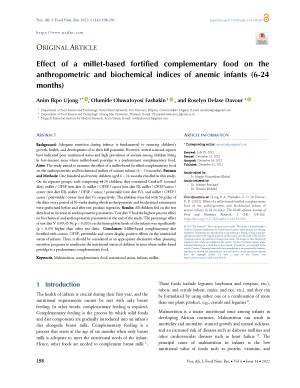Main Article Content
Effect of a millet-based fortified complementary food on the anthropometric and biochemical indices of anemic infants (6-24 months)
Abstract
Background: Adequate nutrition during infancy is fundamental to ensuring children’s growth, health, and development of to their full potential. However, several national reports have indicated poor nutritional status and high prevalence of anemia among children living in low-income areas where millet-based porridge is a predominant complementary food. Aims: The study aimed to examine the effect of a millet-based fortified complementary food on the anthropometric and biochemical indices of anemic infants (6 – 24 months). Patients and Methods: One hundred and twenty children aged 6 – 24 months enrolled in this study. On six separate groups, each comprising of 20 children, they consumed CerelacÒ (control diet), millet / OFSP (test diet 1), millet / OFSP / carrot (test diet II), millet / OFSP/carrot / oyster (test diet III), millet / OFSP / carrot / periwinkle (test diet IV), and millet / OFSP / carrot / periwinkle / oyster (test diet V), respectively. The children were fed with 50 g/day of the diets over a period of 36 weeks during which anthropometric and biochemical assessments were performed before and after test product ingestion. Results: All children fed on the test diets had an increase in anthropometric parameters. Test diet V had the highest percent effect on biochemical and anthropometric parameters at the end of the study. The percentage effect of test diet V (109.45 %; p = 0.020) on the hemoglobin levels of the infants was significantly (p < 0.05) higher than other test diets. Conclusion: Millet-based complementary diet fortified with carrots, OFSP, periwinkle and oyster display positive effects on the nutritional status of infants. Thus, it should be considered as an appropriate alternative when planning nutrition programs to ameliorate the nutritional status of children in areas where millet-based porridge is a predominant complementary food.







